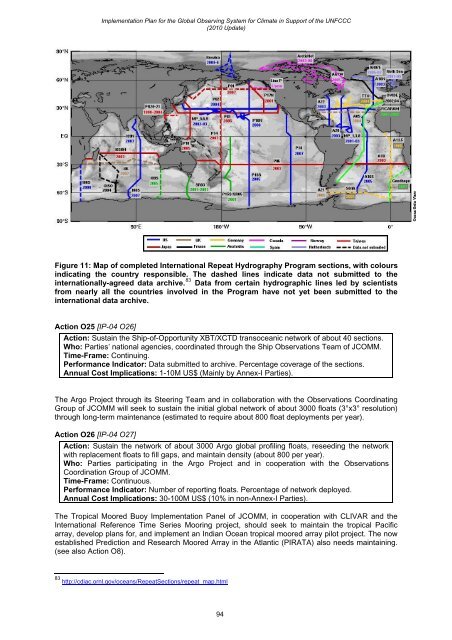GCOS Implementation Plan - WMO
GCOS Implementation Plan - WMO
GCOS Implementation Plan - WMO
Create successful ePaper yourself
Turn your PDF publications into a flip-book with our unique Google optimized e-Paper software.
<strong>Implementation</strong> <strong>Plan</strong> for the Global Observing System for Climate in Support of the UNFCCC<br />
(2010 Update)<br />
Figure 11: Map of completed International Repeat Hydrography Program sections, with colours<br />
indicating the country responsible. The dashed lines indicate data not submitted to the<br />
internationally-agreed data archive. 83 Data from certain hydrographic lines led by scientists<br />
from nearly all the countries involved in the Program have not yet been submitted to the<br />
international data archive.<br />
Action O25 [IP-04 O26]<br />
Action: Sustain the Ship-of-Opportunity XBT/XCTD transoceanic network of about 40 sections.<br />
Who: Parties’ national agencies, coordinated through the Ship Observations Team of JCOMM.<br />
Time-Frame: Continuing.<br />
Performance Indicator: Data submitted to archive. Percentage coverage of the sections.<br />
Annual Cost Implications: 1-10M US$ (Mainly by Annex-I Parties).<br />
The Argo Project through its Steering Team and in collaboration with the Observations Coordinating<br />
Group of JCOMM will seek to sustain the initial global network of about 3000 floats (3°x3° resolution)<br />
through long-term maintenance (estimated to require about 800 float deployments per year).<br />
Action O26 [IP-04 O27]<br />
Action: Sustain the network of about 3000 Argo global profiling floats, reseeding the network<br />
with replacement floats to fill gaps, and maintain density (about 800 per year).<br />
Who: Parties participating in the Argo Project and in cooperation with the Observations<br />
Coordination Group of JCOMM.<br />
Time-Frame: Continuous.<br />
Performance Indicator: Number of reporting floats. Percentage of network deployed.<br />
Annual Cost Implications: 30-100M US$ (10% in non-Annex-I Parties).<br />
The Tropical Moored Buoy <strong>Implementation</strong> Panel of JCOMM, in cooperation with CLIVAR and the<br />
International Reference Time Series Mooring project, should seek to maintain the tropical Pacific<br />
array, develop plans for, and implement an Indian Ocean tropical moored array pilot project. The now<br />
established Prediction and Research Moored Array in the Atlantic (PIRATA) also needs maintaining.<br />
(see also Action O8).<br />
83 http://cdiac.ornl.gov/oceans/RepeatSections/repeat_map.html<br />
94
















